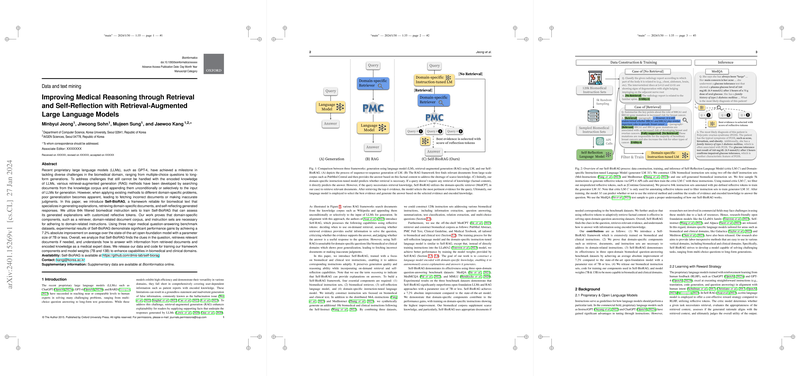Introduction
LLMs like GPT-4 have made significant contributions to fields such as biomedical text analysis. However, when tackling domain-specific problems, general retrieval-augmented generation (RAG) methods often exhibit poor generalization, resulting in incorrect document retrieval or judgment. In response, a new framework has been introduced, Self-BioRAG, aimed at improving medical reasoning through retrieval and self-reflection specifically tailored for the biomedical domain.
Background
The benchmark for Self-BioRAG's performance is established against well-known proprietary and open-source LLMs. While proprietary LLMs have advanced in instruction tuning, their limited access poses a challenge for researchers in the biomedical area. Open-source alternatives like the LLaMA family, consequently, have garnered interest, albeit with room for domain-specific improvements. Furthermore, Self-RAG, a model designed for cost-efficient retrieval with reflective tokens capable of self-assessment, was previously introduced but found inadequate for biomedical queries.
Self-BioRAG Framework
The construction of Self-BioRAG encompasses four integral components: instructional sets pertinent to biomedical and clinical texts, a specialized retriever for this domain, a self-reflection LLM which can critique its own outputs, and a domain-specific, instruction-tuned generator LLM. Instruction sets were crafted with existing biomedical tasks in mind, and a robust biomedical corpus was compiled, featuring medical textbooks, PubMed abstracts, clinical guidelines, and PMC full-text articles. The training processes for each LLM imitate that of Self-RAG, with an additional refining step using data from domain-specific components to improve model performance.
Experimental Results
Experimentation across three major medical question-answering benchmark datasets demonstrated Self-BioRAG's significant performance gains, outperforming the SOTA model average by a substantial 7.2% for languages models with parameters of 7 billion or less. The framework, tested in various configurations, indicates that factual content retrieval is most effective when done adaptively depending on the question. Furthermore, the retriever's bias towards Medical Textbooks suggests a strong relevance to USMLE-style questions, indicating a nuanced understanding of biomedical knowledge needs. The contribution of domain-specific components undeniably underpins the model's heightened performance, and the authors have made the code and data available for public use to further capabilities in this vertical.
Conclusion
Self-BioRAG represents a significant stride towards enhancing LLMs' effectiveness in the biomedical field. Its domain-specific components prove fundamental in enabling the model to autonomously appraise its generated responses and explanations, closely mimicking medical expert behavior. Limitations, such as performance drops in closed-domain datasets where excessive noise hampers the model, indicate potential areas for future refinement. By addressing these challenges, further advancements could lead to LLMs that not only generate but critique and improve upon their knowledge-based outputs in highly specialized fields such as medicine.
